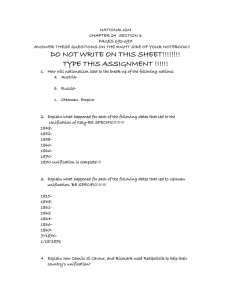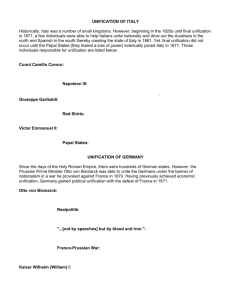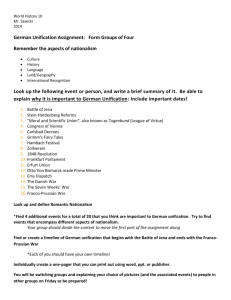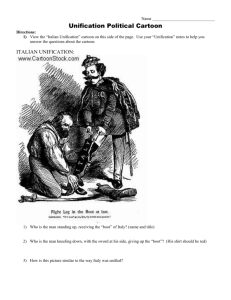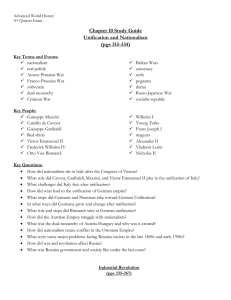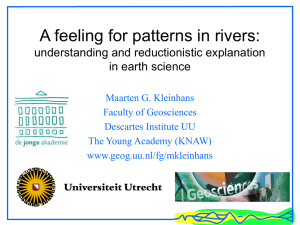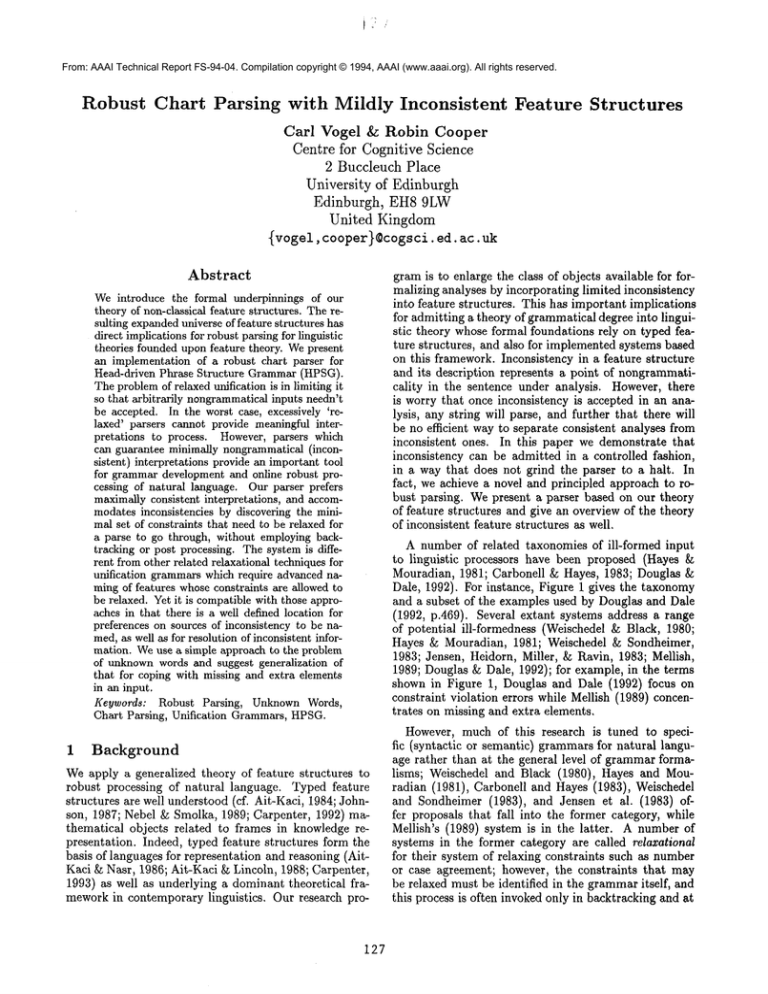
From: AAAI Technical Report FS-94-04. Compilation copyright © 1994, AAAI (www.aaai.org). All rights reserved.
Robust Chart Parsing
with Mildly Inconsistent
Feature Structures
Carl Vogel &= Robin Cooper
Centre for Cognitive Science
2 Buccleuch Place
University of Edinburgh
Edinburgh, EH8 9LW
United Kingdom
{vogel, cooper}©cogsci, ed. ac. uk
Abstract
gramis to enlarge the class of objects available for formalizing analyses by incorporating limited inconsistency
into feature structures. This has important implications
for admitting a theory of grammatical degree into linguistic theory whose formal foundations rely on typed feature structures, and also for implemented systems based
on this framework. Inconsistency in a feature structure
and its description represents a point of nongrammaticality in the sentence under analysis. However, there
is worry that once inconsistency is accepted in an analysis, any string will parse, and further that there will
be no efficient way to separate consistent analyses from
inconsistent ones. In this paper we demonstrate that
inconsistency can be admitted in a controlled fashion,
in a way that does not grind the parser to a halt. In
fact, we achieve a novel and principled approach to robust parsing. Wepresent a parser based on our theory
of feature structures and give an overview of the theory
of inconsistent feature structures as well.
Weintroduce the formal underpinnings of our
theory of non-classical feature structures. The resulting expandeduniverse of feature structures has
direct impficationsfor robust parsing for linguistic
theories founded uponfeature theory. Wepresent
an implementation of a robust chart parser for
Head-driven Phrase Structure Grammar(HPSG).
Theproblemof relaxed unification is in limiting it
so that arbitrarily nongrammaticalinputs needn’t
be accepted. In the worst case, excessively ’relaxed’ parsers cannot provide meaningful interpretations to process. However, parsers which
can guarantee minimally nongrammatical(inconsistent) interpretations provide an important tool
for grammardevelopment and online robust processing of natural language. Our parser prefers
maximallyconsistent interpretations, and accommodates inconsistencies by discovering the minimal set of constraints that need to be relaxed for
a parse to go through, without employingbacktracking or post processing. The systemis different fromother related relaxational techniquesfor
unification grammarswhich require advancednaming of features whoseconstraints are allowed to
be relaxed. Yet it is compatiblewith those approaches in that there is a well defined location for
preferences on sources of inconsistency to be named,as well as for resolution of inconsistent information. Weuse a simple approach to the problem
of unknownwords and suggest generalization of
that for coping with missing and extra elements
in an input.
Keywords: Robust Parsing, Unknown Words,
Chart Parsing, Unification Grammars,HPSG.
1
A number of related taxonomies of ill-formed input
to linguistic processors have been proposed (Hayes
Mouradian, 1981; Carbonell & Hayes, 1983; Douglas &
Dale, 1992). For instance, Figure 1 gives the taxonomy
and a subset of the examples used by Douglas and Dale
(1992, p.469). Several extant systems address a range
of potential ill-formedness (Weischedel & Black, 1980;
Hayes & Mouradian, 1981; Weischedel & Sondheimer,
1983; Jensen, Heidorn, Miller, ~ Ravin, 1983; Mellish,
1989; Douglas & Dale, 1992); for example, in the terms
shown in Figure 1, Douglas and DMe(1992) focus
constraint violation errors while Mellish (1989) concentrates on missing and extra elements.
Background
Weapply a generalized theory of feature structures to
robust processing of natural language. Typed feature
structures are well understood (cf. Ait-Kaci, 1984; Johnson, 1987; Nebel ~ Smolka, 1989; Carpenter, 1992) mathematical objects related to frames in knowledge representation. Indeed, typed feature structures form the
basis of languages for representation and reasoning (AitKaci ~ Nasr, 1986; Ait-Kaci ~ Lincoln, 1988; Carpenter,
1993) as well as underlying a dominant theoretical frameworkin contemporary linguistics.
Our research pro-
127
However, much of this research is tuned to specific (syntactic or semantic) grammarsfor natural language rather than at the general level of grammarformalisms; Weischedel and Black (1980), Hayes and Mouradian (1981), Carbonell and Hayes (1983), Weischedel
and Sondheimer (1983), and Jensen et al. (1983)
fer proposals that fall into the former category, while
Mellish’s (1989) system is in the latter. A number
systems in the former category are called relaxational
for their system of relaxing constraints such as number
or case agreement; however, the constraints that may
be relaxed must be identified in the grammaritself, and
this process is often invoked only in backtracking and at
(1)
(2)
(3)
(4)
Constraint Violation Errors:
a.
Subject-verb numberdisagreement:
¯ The dogs runs.
Premodifier-noun number disagreement:
b.
¯ This dogs runs.
c.
Subject-complement number disagreement:
¯ Thereis five dogshere.
d.
Wrongpronotm case:
, This stays betweenyou and L
e.
Wrongindefinite article:
¯ A apple andan rotten old pear.
Lexical Confusion.
Syntactic Awkwardness.
Missing or extra elements.
Figure 1: Examples of Syntactic Errors
the expense of repeated processing of exactly the same
computations.
Mellish (1989) uses a two-step process based on
active chart parser for unaugmentedcontext free grammar to process a variety of possible errors. He first uses
a standard bottom-up parse and invokes error recovery
only if no complete parse is available for the entire sentence. In that case his system invokes a modified topdown parser which identifies edges that can be tweaked in order to obtain an interpretation for the input.
Mellish’s system is very general; it copes with word deletion, word addition, and unknownwords assuming any
context free grammar without empty productions. An
advantage of his system is that the fully grammatical
parses are identified without additional cost, though the
trade-off is significant processing (though none of it repeated, due to the advantage taken of the well-formed
substring table) during the error recovery stage of processing.
Douglas and Dale (1992) provide a relaxational approach using PATRthe grammar specification formalism
for unification grammars. Their ’Robust PATR’includes specification of ’relaxation puckages’--sets of constraints that are allowed to be relaxed to get a parse
through (the ’package’ means that some constraints are
coupled to others such that one should not be relaxed
without relaxing the rest). The remainder are taken to
be strict. Relaxation packages are associated with each
PATRgrammarrule individually and refer to constraints
mentioned in the scope of &rule. This system is thus attuned to specific grammars, although articulated within
the unification based framework. Douglas and Dale rely
on backtracking when no complete parse is available and
recompute with relaxed constraints.
Weoffer an alternative chart-based relaxational approach to processing ill-formed input that does not rely
on two-stage processing. Our parser is an extension of
the HPSG-PLsystem (Popowich & Vogel, 1991; Kodrie,
Popowich, & Vogel, 1992) which is a Prolog based chart
parser for grammars written in the Head Driven Phrase
Structure Grammar(HPSG; Pollard & Sag, 1987, 1994)
framework. HPSG-PLhas been used as a serious lingui-
128
stics testing bed for HPSGcoverage of complex NPs in
English (Popowich, McFetridge, Fass, & Hall, 1992) and
also for VPand general constituency structure in Slovene
(Kodri6, 1994). In this paper we outline our approach
to ill-formedness arising from constraint violation. A
treatment for unknownwords follows directly from the
technique used by Kodri~ et al. (1992) 1, and for coverage of extra-word, missing-word errors we can ultimately appeal to Mellish’s techniques or to an alternative
post-processing technique related to our proposal for unknownwords. Our approach, like Mellish’s is general to
the grammar framework. Although we could incorporate
a mechanism for stipulating which constraints must be
satisfied, our system identifies the minimal constraints
that need to be relaxed in order to obtain a complete
parse without declaring them in the grammar. This work
is part of our wider research programto define a class of
generalized feature structures which, unlike traditional
approaches (cf. Ait-Kaci, 1984; Johnson, 1987; Carpenter, 1992), admit inconsistencies and therefore offer
mathematical frameworkin which to articulate a theory
of grammatical degree. First we detail the extensions to
the parser that achieve the desired robustness and then
we show the formal generalization of feature structures
which guides our research.
2
A Robust Parser for Natural
Language
2.1
Chart-Parsing Traditional Unification
Grammars
Wequickly review the key aspects of chart parsing methodology that are prerequisite to exposition of our modifications to the framework which achieve robust parsing. The idea is to maintain a chart of edges that represent well-formed substrings (edges have category and
span) of a linguistic input and an agenda of edges to
be processed with respect to the edges already in the
chart and the grammarrules. Edges are either active or
inactive depending on whether they have associated expectations. Expectations originate (in CFGterms) from
the RHSof grammarrules appropriate for an object that
is of that edge’s category. A category corresponds to a
terminal or nonterminal symbol in the grammar. The
two main processing steps are prediction, which generates new active edges for the agenda from inactive edges
in the chart by appealing to grammarrules, and completion, which generates active and inactive edges for the
agenda by satisfying one of the expectations of an active
edge that is found to be adjacent (adjacency may be given discontinuous interpretations) to an inactive edge of
the expected category. An edge generated from completions spans the two constituent edges and is markedwith
the category of the active edge. Parsing is complete when
an inactive edge spans the input. The methodology is
1 In this treatment, there are lexical entries with unspecified phonology, one with an empty subcategorization frame,
one whichsubcategorizes for one other item, and so on. Other
properties are left uninstantiated in the lexicon and are estimatedfrom the knownconstraints that the unknownobject
combineswith.
indifferent to direction of processing; different modesof
access to the agenda (e.g. FIFO, LIFO) achieve different
directions of parsing.
Popowich and Vogel (1991) and Kodri6 et al. (1992)
present the HPSG-PLsystem which adapts the chart parsing methodology to unification grammar frameworks,
particularly
HPSG(Pollard & Sag, 1987, 1994). HPSG
is a dominant frameworkin which formal research in linguistics is conducted. It is a theory of syntax and semantics articulated within a mathematically well-understood
feature structure formalism. The language of attributevalue matrices (AVMs) underneath HPSG can be understood in general terms as constraint satisfaction (cf.
Carpenter, 1993). In HPSG-PL,edge categories are HPSG
signs. Satisfaction of expectations is checked not with
simple symbol matching but with unification. The properties of signs are those of total well-typed feature structure in Carpenter’s (1992) sense. An example sign for
the transitive verb uses is shownin Figure 3; co-indexing
denotes structure sharing, and the items on the SUBCAT
list (subcategorization requirements) are parameterized
types that denote signs as well. The HPSG-PLalgorithm
for classical HPSGchart parsing is given in Figure 2; it
can terminate after the first spanning inactive edge is
found or after all possible parses have been identified.
Data Structures.
¯ Chart of well-formed substrings consisting of edges
with:
- category - HPSGsigns,
- span,
- potency - either active or inactive depending
on expectations.
¯ Agenda of edges to be processed w.r.t, edges in
the chart and grammarrules.
Processes.
¯ Category matching: sign unification.
¯ Prediction: generation of new active edges,
- via appeal to appropriate rules (appropriateness calculated with category matching).
¯ Completion: generation of new active or inactive
edges,
- via combination of adjacent edges with compatible categories;
- new edges span the constituent edges;
- new edges are given the same category as the
active edge in the complementarypair.
¯ Termination: quit when an inactive edge spans
the input.
Figure 2: Chart Parsing for HPSGin HPSG-PL
The sign depicted in Figure 4, includes some of the
information in lexical entries for plural nouns. In a full
phrasal analysis of a sentence that includes both this lexical item and the lexical sign for uses from Figure 3,
in which uses takes drivers as its subject (as in the drivers uses the seatbelts), the sign for drivers will be expected to unify with the nominative NP element of the
verb’s subcategorization list. The co-indexing indicates
that the agreement features of the subject and the verb
should be token identical. However, this is clearly not
the case given those lexical entries: they have differing
values for the NUM
feature. This inconsistency, in classical treatments like Carpenter’s (1992) means that unification fails. Thus, linguistic theory based on a classical
formulation of feature structures is obliged to analyze all
nongrammaticalities as ± (read, "bottom"), the inconsistent feature structure. 2 This, of course, loses all the
information, including the knowledge of which feature
contained an inconsistent value in addition to the consistent information, that is actually available in a nongrammatical sentence. Weprefer a treatment in which
information can be represented and recovered from nongrammaticalsentences like, the drivers uses the seatbelts,
as depicted in Figure 5 with an HPSGphrasal sign with
an inconsistency localized in the value of the root sign’s
I~Mfeature.
2.2 Achieving Robust Processing
To obtain a more robust system from HPSG-PLwe provide an additional, nonclassical unification algorithm for
total feature structures which does not fail upon constant clash. Failure upon constant clash corresponds to
bottom smashing in feature logics (cf. Carpenter, 1992).
Instead, we maintain inconsistencies locally in resultant
structures:
(5) nc_unify([NUMsing], [NUMpl]) = [NUM_l_(sing,pl)]
The symbol I used as the name of a term which marks
inconsistency. The unification of two feature structures maycontain more than one inconsistency, and it is
possible to define a hierarchy of consistency in terms
of cardinality of bottom terms that they contain. This
’paraconsistent’ unification is distinct from default unification which selects one of the conflicting values for
the result (cf. Bouma, 1992; Grover, Brew, Manandhar,
& Moens, 1994). Unlike default unification this relaxed
unification remains associative for nonreentrant structures; however, the class of nonreentrant feature structures
is of limited enough practical interest for this to mean
that relaxed unification is effectively nonassociative as
well.
This sort of unification can fail to unify two feature
structures: we still require graph morphismin the automata interpretation of feature structures. For instance,
two list values of different lengths in otherwise identical
feature structures will be sufficient to cause unification
failure since that is not construable as a constant clash
alone. In HPSG,this means that relaxed unification cannot alone accommodatemissing or extra elements in the
input as manifest in subcategorization list mismatches;
we will discuss below two alternative methods of dealing
in this framework with that type of ill-formedness. In
any case, relaxed unification is accepting enoughto make
2 Or, of course, as T ("top") dependingon which way the
subsumptionhierarchy is specified!
129
i
) -,
PHON
<uses
>
FORMfin
INV -
i
HEAD
SYNSEM
LOC
MA
v[
AGR []
PER
NUM3sing
]
LEX +
SUBCAT
( NP[nom,[]], NP[acc,_]
Figure 3: Part of an HPSGSign for a Transitive Verb
PHON(drivers)
MAJ n [
FORMnorm
PER 3 ]
AGR [] NUM plJ
HEAD
SYNSEM
LOC
LEX +
SUBCAT
( (NP[det, [’i-]])
]
Figure 4: Part of an HPSGSign for a Noun
PHON
( the drivers uses the seatbelts )
HEAD
SYNSEM
MAJ v
FORMfin
INV -
LOC
NUM
.1_(sing,pl)
]
LEX -
s~BCAT
<!
PHON( ses the seatbelts
HEAD-DTR
)
HEAD
SYNSEM
MAJ v
FORMfin
INV -
LOC
NUMsing
LEX SUBCAT( E]NP[nom,[[]]
PHON
( the drivers >
DTRS
COMP-DTRF]
HEAD
SYNSEM
LOC
LEX -
]
MAJ n [
FORM norm
PER 3 ]
AGR [] NUM plJ
]
suBcAT
<>
Figure 5: Part of a Mildly Inconsistent HPSGPhrasal Sign for a Sentence
130
it prudent to restrict its use. Using relaxed unification
in the predictor step would lead to spurious applicability of grammarrules, 3 so we restrict its use to the completion step where constraints on constituents and their
complementsare tested. This restriction guarantees termination in spite of the additional edges produced.
The ~revised system, when given an HPSGgrammar
and input sentence, will produce all of the edges that
unaltered HPSG-PLwould and additional edges reflecting
the relaxed constraint verification that follows from our
nonclassical unification. A revised specification of the
parsing algorithm is given in Figure 6. Wepartition the
agenda through which new edges flow into the normal
agenda for consistent edges, and the robust agenda for
those edges which result because of the relaxed unification. The later may be prioritized according to the
degree of inconsistency in the sign that categorizes each
edge (degree of inconsistency measured in terms of cardinality of .l_-terms in a feature structure). Weappeal
to edges in the robust agenda only when no consistent
parse is available. This prevents inconsistency from propagating unnecessarily. We have also provided a parameter which may be set to retrieve all parses which
are located in terms of increasing inconsistency. There
is great potential for exploring heuristic strategies for
sorting through the robust agenda, either with domaininformed priorities or linguistically motivated strategies,
for exampleallowing preference for inconsistencies on agreement features over inconsistencies in major category.
It is an advantage of our system that it does not require
the advance naming of constraints that can be relaxed
in order to obtain a parse, but it is consistent with those
approaches (e.g. Douglas ~ Dale, 1992) in that preferences can be namedand used as a prioritization metric
on the robust agenda. However, we have so far explored
only minimal inconsistency.
Note also that in comparison to an advanced-naming
approach to constraint relaxation our system is more easily integrated into a system designed to calculate priorities based on statistics like ’most often occurring inconsistency’ obtained by processing novel sentences from
corpora. An advance-naming system always has the potential to be faster than a system that discovers which
constraints to relax, but since, as we just noted, it is
possible to incorporate advance-naming into our system,
and since there will always be novel sentences with previously unexperienced inconsistencies our approach is inherently more flexible.
In the grammar that we have been experimenting
with, we obtain 2 parses for The drivers uses the scatbelts: the first takes the string as a sentence that has
an inconsistency in number agreement. The second takes the string as a noun phrase in which the second the
is seen as an inconsistent sort of NPcomplementto the
verb uses and the ’sentence’ The drivers uses the is taken
ZNotethough that as a lexicalized frameworkthere are
exceedingly few rules in an HPSGgrammar--generally about
5 or 6--since the rules are basically just signs that declare
immediatedominancerestrictions with the main grammatical
constraints expressedthrough universal principles and lexical
entries.
131
Data Structures.
* Chart of edges with category, span, and potency,
as before.
¯ Agenda, partioned:
- normal: old agenda, consistent analyses.
- robust: edges sanctioned by relaxed unification, potential for prioritization on the basis
of degree of inconsistency, source of inconsistency~ etc.
-the idea: remove edges from the robust
agenda for further processing only when the
normal agenda is empty, and no spanning inactive edge is available.
Processes.
¯ Category matching: classical unification and relaxed unification.
¯ Prediction: generation of new active edges,
- via appeal to appropriate rules (classical unification only).
¯ Completion: generation of new active or inactive
edges.
- via combination of adjacent edges with compatible categories (relaxed unification).
¯ Termination: quit when an inactive edge spans
the input.
Figure 6: l~obust Chart Parsing for HPSG.
as an inconsistent sort of determiner for seatbelts. For
practical use of the system it is thus sensible to terminate with minimal inconsistency. However, alternative
priority orderings on the robust agenda clearly would
also have yielded similar results in this case. For instance, if inconsistencies on agreement are preferred over
inconsistencies on major category, then the same minimally inconsistent parse wouldhave been identified first.
Minimal inconsistency is a general prioritizing strategy
that will certainly have overlap with a sensible grammardriven strategy. In fact, exploration of the overlap is an
important task from the perspective of identifying grammar evaluation metrics.
Our system makes only one pass through the input
without backtracking. This works because we use relaxed unification for category matching during the completion step, and relaxed unification includes classical
unifications as a subset. Therefore, it is not necessary to
compute classical unifications, and then invoke relaxed
unification uponclassical failure. Resort to inconsistency
does not entail recomputing consistency checks because
the paraconsistent edges are constructed and stored on
the original pass through the sentence; it is only propagated inconsistency that waits until no consistent parse
is identifiable, and this simply results in additional edges being admitted to the chart and their consequences
followed through before more edges are taken from the
robust agenda. Thus we obtain robust relaxational pro-
cessing of constraint violation errors. The cost, due to
the more complex unification than in a non-robust system, is slower processing during parses that contain no
constraint violations, but an inconsistent unification ta4kes no longer to recognize than a consistent one.
As mentioned earlier, we can adopt the treatment of
unknown words from Kodri5 et al. (1992), and we can
also adopt Mellish’s (1989) post-processing techniques
obtain robust coverage of missing and extra items. The
treatment of unknown words offered by Kodri5 et al.
(1992) in HPSG-PL
postulates lexical entries with unspecified phonology, one with an empty subcategorization
frame, one which subcategorizes for one other item, one
which subcategorizes for two items and one which subcategorizes for three items. These entries can exist up
to arbitrary subcategorization; however, there are precious few English words that subcategorize for more than
three constituents. Whenan input is processed that is
not represented in the lexicon, the underspecified lexical
entries are selected for processing and instantiated with
the phonology of the unknownlexical item in the input
string. Other properties on those underspecified items
are also left uninstantiated in the lexicon, to be later
estimated from the knownconstraints that the unknown
object combines with.
It is possible to further generalize this lexicalized approach to unknownwords to a treatment of the problem
of missing elements as well. This would require an even
more flexible unification operation which matches lists
of different length to form a set of possible feature structures:
(6) f_unify((NP[nom],NP[acc]), (X))
tially missing items. Wepropose the alternative mainly
for its symmetry with our approach to constraint relaxation. It should also be noted that this bifurcation in
ease of robust processing between constraint relaxation
on constant-clashes and relaxation of subcategorization
requirements is significant for a systemthat is to be seen
as a potential model of psycholinguistic behaviors: as a
psycholinguistic model, our system makes a concrete empirical prediction that number agreement errors should
6be ’easier’ to process than subcategorization clashes.
3
Inconsistent
Feature
Structures
Here we sketch the formalization of nonclassical feature
structures that guides our approach to the theory of robust linguistic processing. First consider the rooted directed graph representation of a feature structure; an
example from Carpenter (1992, p.37) is given in Figure 7. For an example of formal definition of classical feature structures refer to Carpenter (1992, p.36)
Keller (1993, p.22). Subsumptionin feature structures
defined in terms of graph morphisms, and unification is
information conjunction. In a classical feature structures, unification of two feature structures gives the least
upperboundif one exists.
noun
SUBJ
~
C) 3rd
s’~yn
{(Nv[nom]>,
Obviously such an operation would have to be extremely limited in its general application, but applied to
missing and extra elements it could be used to unify
lexical entries from the input with the underspecified
elements in the lexicon invoked for unknownwords to
produce new structures with altered subcategoriz&tion
requirements. These new signs can be constructed and
used when edge based activity in the chart fails to produce a spanning inactive edge of the desired category of
phrasal analysis for the input string. In this way, a transitive verb can be reprocessed as an intransitive verb, although semantic information reentrant with the element
on the SUBChT
in the original lexical item will be retained. Thus, post-processing will still have information
to process to conclude from interpretation of The drivers use, that there exists something which the drivers
use. However, we have not implemented an extension
like this in our system. It should be emphasized that
this is a post-processing technique and lacks the sensitivity of Mellish’s approach to correctly identifying poten4Moreover,general recognition speedupis obtained by storing only the root sign information appropriate for the constituency represented by the edge as that edge’s category:
DTRS
(daughter) information can be left implicit in the chart
by also storing (recursively) pointers to the edges whosecategories should be unified as constituents in the full sign for
the parse.
132
Q.) verb
C) sing
Figure 7: An Example Feature Structure
Weprovide an alternative formulation using channel
theoretic notions which make use of type/token distinctions in providing mathematical models for theories that
invoke natural regularity (Barwise, 1991, 1993; Barwise
~; Seligman, 1992, 1993). To relate our work to classical
treatments, take nodes in feature graphs as tokens and
node labels as types. Features are types supported by
connections between nodes.
Dfn. 1 A classification is a structure (S, T, :), where
is a set of tokens, T is a set of types, and: is a relation
on S x T that assigns types to tokens.
Dfn. 2 A feature structure over Type (a set of types)
and Feat (a set of features) is a tuple F = ( Q,..-% "~. C,
where
* Q is a finite set of tokens
. -..* is a binary relation (the connection relation) on
Q and-,~ = U{-,-*e} (see below),
~I amindebted to Holly Braniganfor pointing this out to
me, and for suggesting eyetracking experiments as a method
of investigation.
* ~E Q and for anyq E Qq #~,-4-.~* q (~ is the
6root)
¯ C is a set of classifications
of connections
c = (---%, typec, :c) where:
1. typ% = {f} U {¢ ==~ ¢} where f E Feat and
¢, ¢ 6 Type, and
2. if fl E type c and f’ E Feat then ft = f, and
3. Vq, q’ E Q,q "~c q’ iff (q,q’) :~ f and
<q,q’) :c ¢ -’--->.¢
¯ T E Type (the type of F), and
¯ Vv E Type such that r ~ T,T ~* r is an element
of the transitive closure of the set of indicating relations: {¢ ~ ¢13c : ¢ ~ tb 6 typec]
Links in the feature graph correspond to typed
connections where the types are elements of Feat and
Type × Type. A connection is thus classified by at least
two types: the feature and the indicating relation (~)
on elements of Type. The connection relation (-.-*) and
set of classifications of elements of that relation (C) take
the place of the state transition function 5 in Carpenter’s
definition. As an example of a channel-theoretic model
of a feature structure, consider Figure 8 which depicts a
nonclassical model related to the structure in Figure 7,
differing in a clash on the NUMBER
feature.
Our non-classical feature structures do not have a function assigning types to individual nodes in the feature
graph. The determination of types associated with a
node is derived from classifications of the feature structure containing the node. In particular, the type of a
node is determined by the consequent types in indicating relations (e.g. syn ~ sing or syn =~ plu) associated with connections in which the node participates
(e.g. qt "*NUMB
q and (q’, q) :NUMB
syn ~ sing implies
that q has the type sing). Non-classical feature structures emergefrom the default classification (A; see Dfn. 3),
in which conflicting indications cause inconsistent assignments of types to nodes.
Dfn. 3 The indication classification
based on F, denoted A(F), is a classification, <Q, Type, :n(F)) where:
¯ q :n(F)
¯ q :n(f) ¢ iff 3q’ such that q’ :A(F) and 3c 6 C
such that qt ...% q and ¢c ~ ¢ E type
Dfn. 4 Let OA(F) be a mapping from Q --+ Type,
such that for a feature structure F = (Q,..~,-~,C,T),
0A(F)(q) = iff q :A(F) r
As an example, Figure 9 shows the indication classification of the nodes from the feature structure depicted in
Figure 8, through the 0 mapping. Note that conflicting
types are indicated of the node q6.
Proposition 1 Assume F is a feature structure:
1. 0n(F) is a total mapping;
2. OA(F) is a function iff each connection q .,~
is classified by only one indicating relation, and
Vq, r, s G Q if (q,s) :c¢~¢ and (r,s> :cV~w
then w = ¢;
6Thetransitive closureof ---* is denoted".-+*.
133
Let:
Type= {sent,noun,verb,syn,3rd,sing,pl}
Feat ---- {SUBJ, PRED,AGR,PERSON,
NUMBER}
Then F = (Q,’.-+,~,C,T> is a feature structure over
Type and Feat where:
Q
q
"~
C
T
c,
co
= {ql,qg.,q3, q4, qs, q6}
= ql
= "-%, U "%oU "-%. U "~c.. U "-.%. U "~c=
= {c,,co,c°,cn,c,,cn}
: sent
= <{<ql,q2)},
{SUBJ, sent ::~ noun},
{<<ql, q2), SUBJ>, (<ql, q2>, sent~ noun>})
= <{<ql,q3>},
{PRED,sent =~ verb},
{<<ql, q3), PRED),
<(ql, q3), sent=;~verb>})
c° = <{<q2,q4)],
{AGR,noun ::~ syn],
{(<q2, q4), AGR),((q2, q4), noun::~
cA = ({(q3, q4)},
{AGR,verb ~ syn},
{<(q3, q4), AGR>,
<<q3,q4), verb ::~ syn)})
c+ = <{(q4, qs>},
{PERSON,
syn =:~ 3rd},
{<<q4, as), PERSON>,
<<q4,q5>, syn~ 3rd>}>
=
<{(q4,q6)},
cm
{NUMBER,
syn =~ pl, syn =~ sing},
{<<q4,q6), NUMBER>,
<<q4,as), syn~ pl),
((q4, q6>, syn~ sing>}>
Figure 8: F is a Mildly Inconsistent Feature Structure
3. the equation 0n(F)(q) is computable in li near
time relative to the size of the input feature structure;
4. if 0 is a function On(F)(q) is computable in linear
time relative to the size of the input feature structure;
5. Given an arbitrary feature structure, On(F)(q) is
NP-hard computation.
Proofs of each of the parts of Proposition 1 follow. Essentially, the proposition shows that determination of
the classification of a node in a wide class of feature
structures remains an efficient computation.
Proof:
1.1 1. Recall that Q is connected to ~ by --~ (Vq
q, q --~* q) and all connections are classified:
q’ "--* q D 3c : q’ ---% q, which means that
(q’,q) :~ ¢ ~ ¢ and ¢ ==~ ¢ 6 typ%.
Oa(F)(ql)
OA(F)(q2)
8~(F)(q3)
O~(f)(q4)
OA(f)(qs)
OA(F)(q6)
sent
noun
---- verb
---- syn
---- 3rd
= sing
0A(F) (q6)
:
see Dfn. 5) formalizes this; Figure 10 shows the univocal classification of the nodes from the feature structure
modeled in Figure 8. This definition can be modified
to provide a total typing function on all nodes similar
to Ait-Kaci’s (1984) definition. His formulation admitted inconsistencies at nodes but then ruled them out via
smashing to obtain i for the whole feature structure.
Weleave the inconsistencies in place in the A classification and moveto agnosticism with respect to the types
of the same nodes in the U classification. Our treatment
is similar to that which would be provided by a 4-valued
logic for feature structures (Sch6ter, 1992, 1994).
=
=
pl
Figure 9: Types Indicated of the Nodes in the Feature
Structure from Figure 8
Also recall that Type is connected to T by ~:
Vr q Type such that r # T, T ~* r is an element of the transitive closure of {¢ ==~ ¢13c :
¢ ==~ ¢ 6 typec}.
Since ~ :z~(F) T, Vq ¢ ~ such that ~-~
we also knowthat (~, q) :c T =:=V r, and thus
q :Z~(F)
2. Assumethat Vq if Sq’ 6 Q : q’ ~-** q, then
3¢ E Type such that 3c : (q’, q> :c ¢ ~ ¢ and
q’ :a(f)
Since ¢ ~ ¢ 6 typ% and q’ :a(f)
q :A(F)
1.2 This follows in the above proof by noting that as
well as obtaining types from indicating relations
that classify connections in which a token participates, under the assumptions in the proposition,
each token can be classified by only one indicating
type.
1.3 This assumes that indicating relations are composed of atomic types alone, in which case they
can be seen as transitions in a finite state automaton. Verifying whether an arbitrary token q is
A-classifiable by v just requires being able to move
from the start token to q along both the indicating
and connection relations. The split between type
and token levels offers no additional complexity.
1.4 The argument will build a construction similar to
the above: ~’s being a function guarantees only one
indicating relation per connection relation, and only
one type per token. Thus, determining the type
assigned to q entails verifying that ~ -,-** q, and
calculating corresponding type. (We also assume
the same restricted calculus of types).
1.5 Informally, this is because it requires enumerating
all the types that a feature structure indicates the
token to be; this enumeration problem is exponential in the worst case where 6 is not a function.
[]
Classical feature structures, particularly as defined by
Carpenter (1992), are a restriction of default classification in which arbitrary nodes either have a unique type
or have no type at all. The univocal classification (U;
134
Dfn. 5 The univocal classification
based on F, denoted
U(F), is a classification, (Q, Type, :U(F)> such that:
¯ Vq, q :U(F) ¢ /re = A{¢ I q :z~(F) and¢ is
consistent
¯ otherwise, "~3¢ such that q :U(F)
ql
q2
q3
q5
:U(F) sent
:U(F) noun
:U(F) verb
syn
:U(F)
:U(F) 3rd
q6
:U(F) UNDEFINED
q4
Figure 10: Univocal Classification
Structure
of Nodes in a Feature
It is possible to consider just the restricted universe
of consistent feature structures, but these are properly
contained in a hierarchy of inconsistent structures. We
define a relative inconsistency ordering based on cardinality of inconsistencies contained in a feature structure so
that we can refer to the minimally inconsistent structures. To do this, we assume total typedness; thus we can
comparethe feature structure which has all features defined but no values specified at terminal paths in the structure with the maximallyinconsistent structure which has
a _l_-term as the value of each feature in the structure,
and with all of the feature structures with intermediate
degrees of instantiation and inconsistency.
The robust parser that we have presented captures
the distinction between consistent and inconsistent elements in this hierarchy. It should be clear that the parser
produces sound analyses with respect to the space of feature structures we consider, but its description language
is not complete. Our non-classical feature structures are
richer than objects supplied by other theories of feature
structures which lack the binary type-level relation that
indicates the types of nodes. In addition to supplying information about the inconsistency of types supported by
nodes, indicating relationships supply the origins of type
conflicts. While the description language in our parser
represents the existence of inconsistencies, we have not
implemented a description language that expresses the
source of inconsistency. Clearly, this additional information derived from linguistic regularities can offer critical advantage to a system designed to integrate domainstyle reasoning with linguistic processing. Wehave not
yet provided a way in either the parser or the theory of
feature structures with which to articulate a preference
ordering on features structures which would yield, for
instance, preference for certain feature structures over
others with equal cardinality of inconsistency.
4
Discussion
Wehave presented a robust chart parser for HPSG.The
system uses a relaxed unification operation which is applied judiciously during the chart-parsing algorithm to
discover the constraints which need to be relaxed in an
arbitrary HPSGin order to obtain minimally inconsistent feature structures that correspond to analyses attributing minimal nongrammaticality to the inputs. The
algorithm and techniques that we suggest are applicable
to robust chart parsing for unification grammarsin general.
Wehave a treatment for unknownwords, and suggest
a methodfor generalizing this treatment to contend with
missing and extra elements in sentences to be parsed as
well. Like Mellish’s (1989) technique for the latter problem, our suggestion involves post-processing. However,
the relaxational component of the system is not based
on backtracking. The effect on time-complexity is a penalty on processing completely grammatical inputs, thus
it would be interesting in the future to explore modifications to the system which invoke relaxed unification
only when classical unification will not admit a parse.
This, of course, makes the cost of parsing nongrammatical inputs significantly more dear than in our system,
but it would be a useful exercise to determine the issues which should decide which conditions make either
approach more attractive.
In terms of space complexity, SchSter (1994) has pointed out that the relaxed unification that we use in
backtracking-free parsing has space complexity proportional to O(n) (where n = the number of categories in
the feature description) when applied to consistent feature descriptions, which is the same space complexity of
classical unification. In the general case, the space complexity of relaxed unification is proportional to O(2’~).
Thus, in terms of other approaches to paraconsistency
in feature logics, our approach is on the low end of the
complexity scale (since other paraconsistent systems can
require exponential space for the consistent case as well
(SchSter, 1994)).
Wehave argued that our approach which involves discovering the constraints which need to be relaxed in
order to obtain an analysis of a sentence is more flexible
than approaches like Douglas and Dale’ (1992) which
require the naming in advance of the features whose
constraints can be relaxed. Advanced-naming approaches are more closely bound to specific grammars, and
therefore offer potential computational advantage. We
proposed to incorporate a facility for prioritizing the robust agenda based on preferences for sources of inconsistency (for instance, preferring analyses that have num-
135
ber clash over those which have inconsistencies on major
category). Such an enhancement would offer the advantages of advanced-naming, but would let our system retain its greater robustness in coping with novel feature
clashes.
It would be extremely interesting to develop a postparsing interpretation module which examines the feature descriptions produced by our system and based on
domain features or user models (e.g. when dealing with
native speakers of language X assume that the number
information supplied by the phrasal head is the intended information, but for native speakers of language Y
assume that the complementcontains the intended information). Our system can be used as a tool in the empirical determination of what those preferences should
be by monitoring the frequency with which particular
inconsistencies occur in relevant classes of corpora. However, we have not proposed an architecture for a module which attempts to resolve inconsistencies. For this,
it would be useful to examine other approaches that integrate domain reasoning with linguistic representation
(e.g. Iwafiska, 1992).
Finally, we have presented the formalization of nonclassical feature structures that guides our research in
paraconsistent feature logic. Weare currently exploring
the relationship between our system and other possible
description languages for the expanded universe of feature structures that we propose. Wehave not yet determined the most appropriate logic for our needs and theoretical interests. Weoffer the present paper as proof of
the concept that parsers for unification grammarsbased
on feature theory can practically incorporate the representational advantages offered by a nonclassical feature
theory that admits local inconsistency.
Acknowledgements
Vogel is grateful to the Marshall Aid Commemoration
Commission for supporting his stay in Edinburgh. Both Vogel
and Cooper thank the anonymousreviewers, Toma~Erjavec,
Andreas Sch6ter and the LanguageTechnologyGroup within
the HumanCommunicationsResearch Centre for insightful
commentsand feedback.
References
Ait-Kaci, H. (1984). A Lattice Theoretic Approach to
Computation Based on a Calculus of Partially Ordered Types. Ph.D. thesis, Computerand Information Sciences, University of Pennsylvania.
Ait-Kaci, H. & Lincoln, P. (1988). LIFE A Natural Language for Natural Language. Tech. rep. ACA-ST074-88, Systems Technology Laboratory, Univ. of
Austin.
Ait-Kaci,
H. & Nasr, R. (1986). LOGIN: A Logic
ProgrammingLanguage with Built-in Inheritance.
Journal of Logic Programming, 3, 185-215.
Barwise, J. (1991). Information Links in DomainTheory.
Tech. rep. IULG-91-7, Indiana University Logic
Group.
Barwise, J. (1993). Constraints, Channels, and the Flow
of Information. In Situation Theory and its Applications, Volume 3. CSLI Lecture Notes no. 37.
Barwise, J. & Seligman, J. (1992). The Rights and
Wrongsof Natural Regularity. Philosophical Perspectives, 8 or 9. to appear.
Barwise, J. & Seligman, J. (1993). Imperfect Information
Flow. In Logic in Computer Science.
Bouma, G. (1992). Feature Structures and Nonmonotonicity. Computational Linguistics, 18(2). Special
Issue on Inheritance I.
Carbonell, J. G. &; Hayes, P. J. (1983). Recovery Strategies for Parsing Extragrammatical Language.
American Journal of Computational Linguistics,
9 (3-4). Special Issue on Ill-Formed Input.
Carpenter, B. (1992). The Logic of Typed Feature Structures. Cambridge Tracts in Theoretical Computer
Science 32.
Carpenter, B. (1993). ALE. The Attribute Logic Engine
User’s Guide. Tech. rep. version j3, Laboratory for
Computational Linguistics, Carnegie Mellon University.
Douglas, S. ~ Dale, R. (1992). Towards robust PATR.
In Proceedings of COLING92: l~th International
Conference on Computational Linguistics.
Grover, C., Brew, C., Manandhar, S., & Moens, M.
(1994). Priority Union and Generalization in Discourse Grammars. In Proceedings of the 32nd Annual Meeting of the Association for Computational
Linguistics.
Hayes, P. J. & Mouradian, G. V. (1981). Flexible Parsing. American Journal of Computational Linguistics, 7(4).
Iwafiska, Lucja. (1992). A General Semantic Model
Negation in Natural Language. In Proceedings
of the Third International Conference on Principles of Knowledge Representation and Reasoning.
Cambridge, MA. October 25-29, 1992.
Jensen, K., Heidorn, G. E., Miller, L. A., & Ravin, Y.
(1983). Parse Fitting and Prose Fixing: Getting
a Hold on Ill-Formedness. American Journal of
Computational Linguistics, 9(3-4). Special Issue
on Ill-Formed Input.
Johnson, M. (1987). Attribute-Value
Logic and the
Theory of Grammar. Ph.D. thesis, Department
of Linguistics, Stanford University, CA.
Keller, B. (1993). Feature-Logics, Infinitary Descriptions, and Grammar.Centre for the Study of Language and Information, Stanford University, CA.
CSLI Lecture Notes Number 44.
KodriS, S. (1994). VP Constituency and Clause Structure in Slovene. Slovene Studies, 15. to appear.
Kodri~, S., Popowich, F., & Vogel, C. (1992). The
HPSG-PLSystem: Version 1.2. Tech. rep. CSS-IS
TR 92-05, CMPTTR 92-08, School of Computing
Science, Simon Fraser University, Burnaby, B.C.
136
Mellish, C. S. (1989). Some Chart-Based Techniques
for Parsing Ill-Formed Input. In Proceedings of
the 27th Annual Meeting of the Association for
Computational Linguistics. Vancouver, BC.
Nebel, B. & Smolka, G. (1989). Representing and Reasoning with Attributive Descriptions. Tech. rep.
IWBSReport 81, IBM Deutschland, Stuttgart,
Germany.
Pollard, C. & Sag, I. (1987). Information-Based Syntax
and Semantics, Volume 1: Fundamentals. Centre for the Study of Language and Information,
Stanford University, CA.
Pollard, C. & Sag, I. (1994). Head-Driven Phrase Structure Grammar. forthcoming, University of Chicago Press and CSLI Publications.
Popowich, F., McFetridge, P., Fass, D., & Hall, G.
(1992). Processing Complex Noun Phrases in
Natural Language Interface to a Statistical Database. In Proceedings of COLING
92: 14th International Conference on Computational Linguistics.
Popowich, F. & Vogel, C. (1991). A Logic Based
Implementation of Head-Driven Phrase Structure
Grammar. In Brown, C. & Koch, G. (Eds.), Natural Language Understanding and Logic Programming, III, pp. 227-246. Elsevier, North-Holland.
SchSter, A. (1992). Partial Logic, Logic Programming
and Unification. MScThesis, Centre for Cognitive
Science, University of Edinburgh.
Sch5ter, A. (1994). Paraconsistent Feature Logic. Unpublished manuscript, Centre for Cognitive Science,
University of Edinburgh.
Weischedel, R. M. ~ Black, J. E. (1980). Responding Intelligently to Unparsable Inputs. American Journal of Computational Linguistics, 6(2).
Weischedel, R. M. ~ Sondheimer, N. K. (1983). MetaRules as a Basis for Processing Ill-Formed Input.
American Journal of Computational Linguistics,
9 (3-4). Special Issue on Ill-Formed Input.

